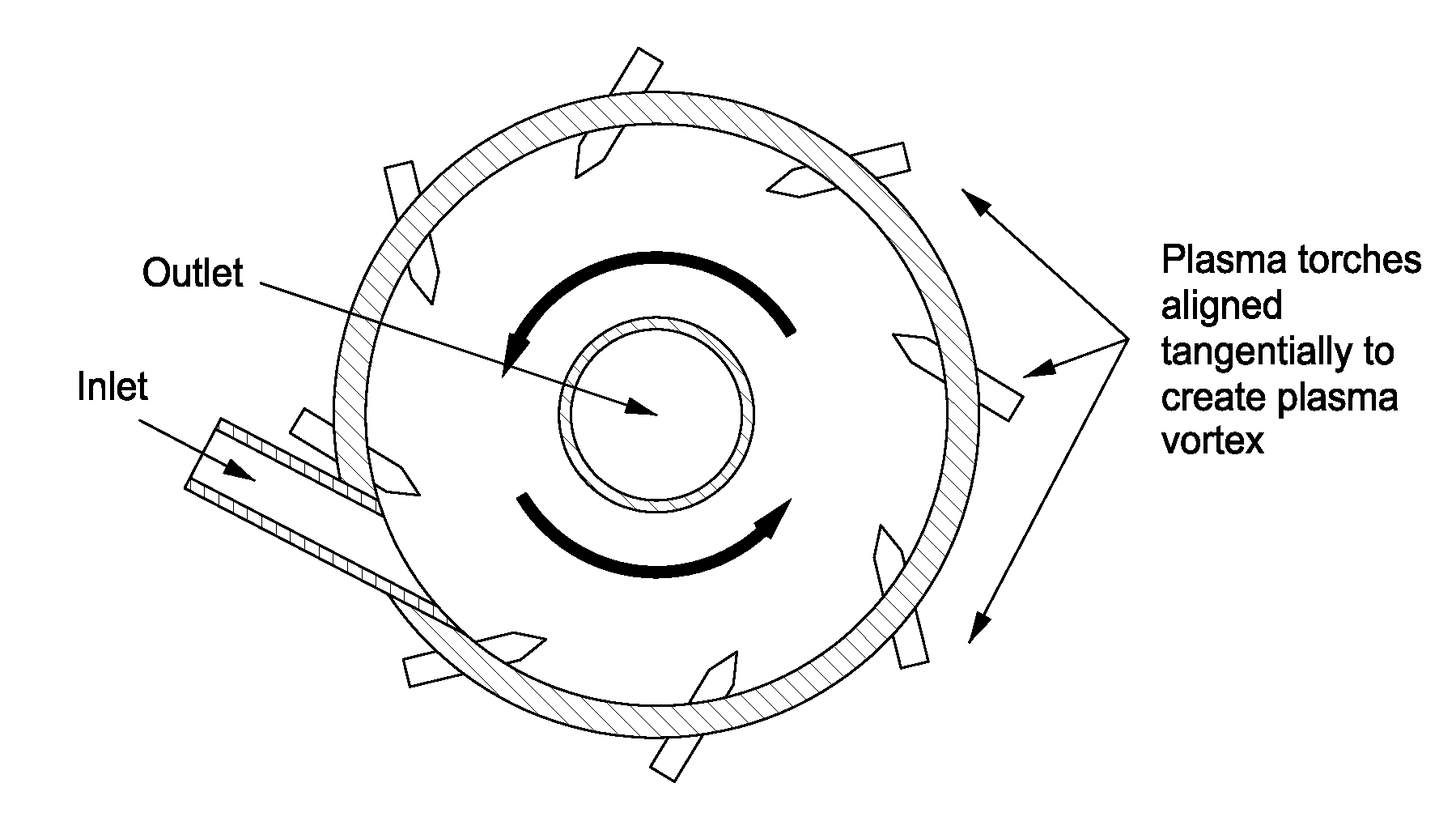Method for treating a substance with wave energy from plasma and an electrical arc
a technology of wave energy and plasma, applied in the field of apparatus and methods for processing materials with plasma and electrical arc, can solve the problems of unfiltered small particles, untapped energy source, waste of vented or flared gas,
- Summary
- Abstract
- Description
- Claims
- Application Information
AI Technical Summary
Benefits of technology
Problems solved by technology
Method used
Image
Examples
seventh embodiment
[0309]FIG. 13 is a diagrammatic, cross-sectional side view of a seventh embodiment Plasma & Arc Whirl Reactor 1300. The Plasma & Arc Whirl Reactor 1300 includes a vessel having (a) an interior 1302 defined by a cylindrical portion 1304 disposed between a first end 1306 and a second end 1308, (b) an outlet 112 in the first end 1306 that is aligned with a longitudinal axis 1310 of the cylindrical portion 1304, (c) an inlet 106 in the cylindrical portion 1304 to receive the material C, (d) a first wave energy source comprising a first electrode 1312 disposed at least partially within the outlet 112 and aligned with the longitudinal axis 1310, and a second electrode 1314 disposed at least partially within the second end 1308, aligned with the longitudinal axis 1310 and spaced apart from the first electrode 1312, (e) a second wave energy source comprising a set of radio frequency coils or windings 105 disposed around or within the cylindrical portion 1304, and (f) two or more jets or sli...
eighth embodiment
[0318]FIG. 15 is a diagrammatic, cross-sectional side view of an eighth embodiment Plasma & Arc Mill Reactor 1500. The Plasma & Arc Mill Reactor 1500 includes a vessel having (a) an interior 1302 defined by a cylindrical portion 1304 disposed between a first end 1306 and a second end 1308, (b) an outlet 112 in the first end 1306 that is aligned with a longitudinal axis 1310 of the cylindrical portion 1304, (c) an inlet 106 in the first end 1306 to receive the material C, (d) a first wave energy source comprising a first electrode 1312 disposed at least partially within the outlet 112 and aligned with the longitudinal axis 1310, and a second electrode 1314 disposed at least partially within the second end 1308, aligned with the longitudinal axis 1310 and spaced apart from the first electrode 1312, (e) a second wave energy source comprising a set of radio frequency coils or windings 105 disposed around or within the cylindrical portion 1304, and (f) two or more jets or slits 104 withi...
ninth embodiment
[0327]FIG. 16 is a diagrammatic, cross-sectional side view of a ninth embodiment Hyper Plasma & Arc Cyclone Separator Reactor 1600. The Hyper Plasma & Arc Cyclone Separator Reactor 1600 includes a vessel having (a) an interior 1302 defined by a cylindrical portion 1304 disposed between a first end 1306 and a cone shaped second end 1602, (b) a first outlet 112 in the first end 1306 that is aligned with a longitudinal axis 1310 of the cylindrical portion 1304, (c) a second outlet 1604 in the cone shaped second end 1602 that is aligned with the longitudinal axis 1310, (d) an inlet 106 in the first end 1306 to receive the material C, (e) a first wave energy source comprising a first electrode 1312 disposed at least partially within the first outlet 112 and aligned with the longitudinal axis 1310, and a second electrode 1314 disposed at least partially within the second outlet 1604, aligned with the longitudinal axis 1310 and spaced apart from the first electrode 1312, (f) a second wave ...
PUM
 Login to View More
Login to View More Abstract
Description
Claims
Application Information
 Login to View More
Login to View More - R&D
- Intellectual Property
- Life Sciences
- Materials
- Tech Scout
- Unparalleled Data Quality
- Higher Quality Content
- 60% Fewer Hallucinations
Browse by: Latest US Patents, China's latest patents, Technical Efficacy Thesaurus, Application Domain, Technology Topic, Popular Technical Reports.
© 2025 PatSnap. All rights reserved.Legal|Privacy policy|Modern Slavery Act Transparency Statement|Sitemap|About US| Contact US: help@patsnap.com



